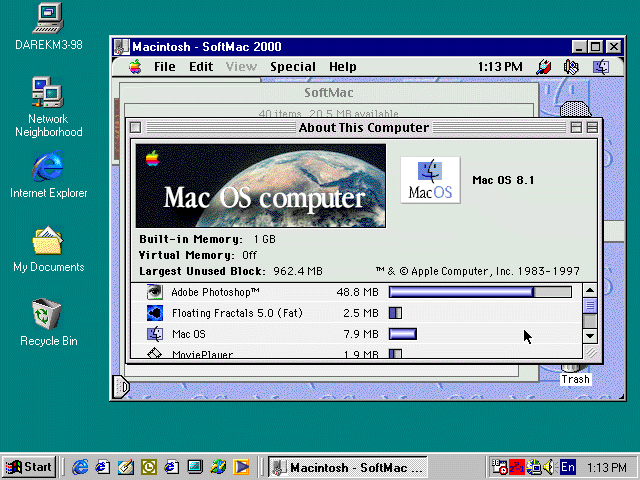

- MAC OS X 10.1 EMULATOR MAC OS X
- MAC OS X 10.1 EMULATOR UPDATE
- MAC OS X 10.1 EMULATOR SOFTWARE
- MAC OS X 10.1 EMULATOR CODE
Want a comparison? If you bought OS X for $129 when it came out in 2001 it would cost well over $150 in 2009 dollars. The speed and solidity of Snow Leopard will sell a ton of new Macs, while existing users will benefit from the same things at a price that is insanely low. Apple is setting up the platform to do amazing things in the future without being bogged down with legacy code. While Snow Leopard may not have been cheaper to develop than previous releases (although one imagines that dropping the burden of coding, QA and support for the legacy PPC platform has created some economies), Apple has decided to lop $100 off the usual price this tradeoff of OS sales profit for increased adoption shows Apple is taking the long view, something the company sometimes skips. The answer: just give it away, or nearly. But perception is everything and many will not see the immediate value of the improvements focusing instead on a lack of new whizzy features. This goes against the grain of Apple's position of not wanting anyone to worry about what the little man behind the curtain is doing since 'it just works.' This time it's all about speed and how much better it works. In effect, where's the beef? The beef is under the hood this time. I would expect a large group of users to not be mollified by a nicer QuickTime and an improvement to Stacks. What a perfect time to work under the hood, set up the core of the operating system for the future and stabilize what's already there! But of course you can't make everyone happy. There will always be users who want four ways to do the same thing, but for others, feature-laden releases are overwhelming and the glimmer and excitement of a new OS X release has faded.
MAC OS X 10.1 EMULATOR MAC OS X
Mac OS X 10.6 will be the fifth major release in eight years, and some users are complaining about feature overload.

The sales pitch is always the same: with each new version, OS X gets new features and an "enhanced computing experience" which largely depended upon how much you like the new features.
MAC OS X 10.1 EMULATOR UPDATE
Apple first introduced Mac OS X in 2001, and excluding the free update to Mac OS X 10.1 from Mac OS X 10.0, a new version of the OS has been released roughly every 18 months, always at a price of $129.

When I saw this on the video stream of the WWDC keynote address my jaw dropped, my eyes glazed and only later did it start making sense to me. It is going to sell Snow Leopard for $29. Whenever something like this happens there is a potential for a marketing meltdown, but this time Apple is doing something brilliant. Once again, the major reason for dropping legacy support is speed. This time it took eleven years from inception to extinction (well, three for the Intel transition), but even so I can hear the hue and cry machine cranking up. In September Apple will release Snow Leopard, which will only run on Intel based Macs, thus cutting off PowerPC support.

It took Apple only four years to introduce the PowerPC chip and make any Mac without it obsolete.
MAC OS X 10.1 EMULATOR CODE
Of course, most Power Mac users loved the newfound speed introduced in Mac OS 8.5, thanks to code optimized for PowerPC processors and jettisoned emulation support. In user groups, USENET and the Internet (which was only starting to explode), apoplectic non-PowerPC Mac owners threatened class action lawsuits and the rending of garments. What happened was just what you would expect. By 1998, Apple decided it just couldn't support 680X0 emulation for a number of reasons, but chiefly among them was speed. Emulation works, but it also slows things down. Earlier Macs ran on some variation of 680x0 processors and were supported mostly via emulation in a PowerPC environment.
MAC OS X 10.1 EMULATOR SOFTWARE
As far as system software upgrades go, this was the end of the line for any Mac built before the Power Macintosh 6100, introduced in March 1994. On OctoApple released Mac OS 8.5, the first operating system that ran solely on Macintoshes with PowerPC processors.


 0 kommentar(er)
0 kommentar(er)
